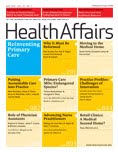
May 4th’s Health Affairs contains a lot of food for thought for Geriatricians and Palliative Care providers thinking about the future of medicine and health care reform.
“A Case of Medical Homelessness” by Dr. Jack M. Colwill (full disclosure, my former chair) sounds like a typical case for any palliative care provider. A patient with advanced emphysema, John–the brother-in-law of the author, doesn’t respond to therapies and becomes progressively weaker, with dyspnea and anxiety. Visits to primary care, a pulmonologist, an interventionalist to drain an effusion do not relieve his symptoms. Then, despite dramatic decline over the next half year, John undergoes surgery for his hand just two months before his death and has a complete set of dentures made (that continue to require payments after his death.) In all 11 doctors were seen, and yet the family felt abandoned. It took a visit from the author/brother-in-law/MD to finally address the issue of advanced directives and prognosis and to reframe care to face the fact that the patient was dying. Finally, hospice came in and saved the day.
The patient was adrift in a complex system, and no physician assumed the responsibility of care coordination. Colwill attributes medical homelessness to what Diane Meier has called “the Original Sin of Medicare” where financial incentives are misaligned as payments are made for numbers of visits, as opposed to outcomes. Furthermore, the shortage of primary care physicians create impossible work load demands that prevent true coordination of care. Dr. Colwill concludes that what is needed is a Patient-Centered Medical Home (PCMH). And I think that we could also add Palliative Medicine was needed earlier!!
The entire issue goes on to address Reinventing Primary Care. For fans of podcasting listen to Annals of Internal Medicine’s May 18, 2010 podcast (at approximately the 11th minute and 10 seconds mark) to hear why the primary care workday should be reinvented to manage more disease by phone and email (and get paid). Then listen to the experience of transition to a PCMH for one health system, and finally hear an experience with electronic referrals.
In the print edition, the history of primary care is reviewed, and an evidence base for the value of primary care is presented. Seven articles explore the Medical Home concept as a solution, including an overview of the experience of Group Health of Seattle moving to the Medical Home. Other articles address the role of teams including articles addressing the importance of Physician Assistants, Nurse Practitioners, and Pharmacists in the Medical Home concept. (Shocking news to the Geriatricians and PC providers!) Articles on patient perspectives on PCMH as well as payment structures for the PCMH concept follow. Phillips and Bazemore argue that to be on par with other developed nations, the United States should double the current investment in primary care to 10-12% of health care expenditures, and make the point that the reduction in total health care costs would make up for the investment.
Geriatricians (and I would argue PC providers too) will be especially interested in “The Urgency of Preparing Primary Care Physicians to Care for Older People with Chronic Illnesses” by Chad Boult, Steven Counsell, Rosanne Leipzig and Robert Berenson. They describe 3 choices for the future of geriatrics: 1. Continue the status quo, training modest numbers of fellows and hope that they revitalize the discipline-a choice they describe as doomed to fail. 2. Redouble existing efforts to recruit more fellows- another pathway to failure they conclude. 3. Reinvent geriatrics as a discipline of geriatrician leaders/educators who train many disciplines in geriatric principles and train the trainers within that discipline to become geriatric experts within their field. In particular, geriatricians must train primary care physicians to provide higher quality and more cost-effective care to older people with multiple chronic conditions. They make the point that for this model to work the US must increase the primary care work force, pay adequately for high-quality chronic care, and develop cost-effective modes of chronic care. Palliative care providers can think of this as the concept of Primary, Secondary, and Tertiary Palliative Care.
I think the Boult et. al. article is especially important for both Geriatric Medicine and Palliative Medicine. Despite all of the gains that are made in academic and urban settings, the aging rural population will depend on a good primary care doctor who has the skills to practice both geriatric medicine and palliative care and coordinate care. What have you done to help educate that primary care doc lately??
By: Paul Tatum



